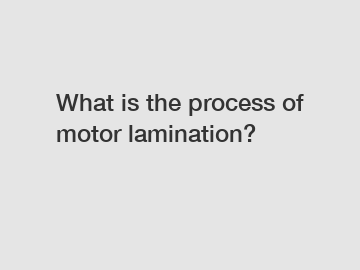What is the process of motor lamination?
Motor lamination is a critical process in the manufacturing of electric motors. It involves the stacking of thin layers of electrical steel to create the core of the motor. This core is essential for reducing energy loss and improving the efficiency of the motor. In this article, we will delve into the process of motor lamination, highlighting its importance and the steps involved in achieving a high-quality product.
Importance of Motor Lamination.
Motor lamination plays a crucial role in the efficiency and performance of electric motors. By using laminated cores made from thin sheets of electrical steel, manufacturers can reduce energy loss due to eddy currents. These thin layers are coated with an insulating material to prevent current from flowing through the core, thus minimizing energy losses and improving the overall efficiency of the motor.

In addition, motor lamination helps in reducing vibration and noise during the operation of the motor. The laminated core provides a path for the magnetic field generated by the stator windings, resulting in smooth and efficient operation. Without proper lamination, the motor would experience higher levels of vibration and noise, impacting its overall performance and lifespan.
Furthermore, motor lamination allows manufacturers to design motors with specific characteristics such as high torque, low noise, and improved power density. By using different grades of electrical steel and varying the thickness of the laminations, engineers can tailor the motor's performance to meet the specific requirements of different applications.
The Process of Motor Lamination.
The process of motor lamination involves several steps that are critical to achieving a high-quality core for electric motors. These steps include:
1. Steel Selection: The first step in motor lamination is selecting the appropriate grade of electrical steel. Different grades of steel offer varying magnetic properties and electrical resistivity, which can impact the efficiency and performance of the motor.
2. Cutting and Stamping: Once the steel is selected, it is cut into thin strips and stamped into the desired shape and size. Precision cutting and stamping are essential to ensure that the laminations fit together seamlessly and form a solid core.
3. Insulation Coating: After cutting and stamping, the laminations are coated with an insulating material to prevent current flow through the core. This insulation helps reduce energy losses and improve the overall efficiency of the motor.
4. Stacking: The insulated laminations are then stacked together to form the core of the motor. Careful attention must be paid to the alignment of the laminations to minimize gaps and ensure a solid magnetic path for the stator windings.
5. Bonding: Once the laminations are stacked, they are bonded together using adhesives or welding. This bonding process helps secure the laminations in place and prevent shifting during operation.
6. Final Processing: The final step in motor lamination involves machining the core to achieve the desired dimensions and shape. This machining process ensures that the core fits perfectly within the motor housing and provides optimal performance.
Conclusion.
In conclusion, motor lamination is a critical process in the manufacturing of electric motors. By using thin layers of electrical steel and insulating materials, manufacturers can create cores that reduce energy loss, improve efficiency, and enhance the performance of the motor. The process of motor lamination involves several steps, from steel selection to final processing, all of which are essential to achieving a high-quality product. If you have any questions or need assistance with motor lamination, feel free to contact us.
Contact us for more information on motor lamination and how it can benefit your electric motor manufacturing process.
For more information, please visit stator and rotor in dc motor, custom motor stator and rotor cores, Lamination for New Energy.

Comments